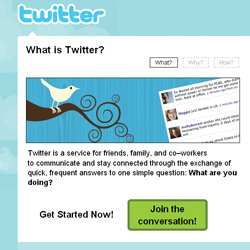
- The latest fad that will eventually fade away
- The biggest time suck since Facebook
- The biggest communications revolution since email.
I vote for “C.” If you haven’t dived into Twitter yet, you should, because your customers, prospects and competitors are tweeting away without you (and maybe even about you).
I won’t claim to be an expert Twitterer yet, but I’ve posted more than 450 messages (“tweets”), read thousands more, and follow some of the best tweeters in the “Twitterverse”: Chris Brogan @chrisbrogan(twitter.com/chrisbrogan), Gary Vaynerchuk @garyvee (twitter.com/garyvee) and Darren Rowse @problogger (twitter.com/problogger).
What I’ve learned: Twitter is a different channel from email, mainly because it’s real-time communications, but the two have many similarities that reinforce best communication practices, no matter which channel you use:
Twitter Lessons for Email, or Vice Versa
- Make every word count. Twitter gives you only 140 characters to convey your message, including spaces and punctuation. That’s about 15 to 25 words, fewer if you include a link or URL. Similarly, with overflowing inboxes, more use of preview panes and mobile devices, your email subject line and above-the-fold copy must sing. Choose your words carefully. Go for impact. Good copywriting is more important than ever.
- Drive people to your website. It’s hard to say a lot in 140 characters. So, most messages need a link to a blog, landing page, etc. In the same way, your email message should drive subscribers to your website, where they will read your content, interact with your brand and take a desired action. The copy surrounding your links is critical. If not, few people will click.
- Start off right. On Twitter, I unfollowed (like unsubscribing) one of the Twitter Elite less than 30 minutes after following, because her first 10 or so tweets meant nothing to me. Were I a long-time follower, I might have overlooked those posts, or even valued them as part of the brand experience. With email, a strong welcome series makes new subscribers feel part of things quickly instead of feeling like observers of random messages.
- Personality is key. The most popular and engaging “Twitterati” exhibit pronounced personalities in their tweets. Consider @garyvee of WineLibrary.com. Do Gary’s rants this past NFL season about the New York Jets help sell wine? Maybe not directly, but this personal insight helps him engage with his audience and, ultimately, sell more wine. Your emails need a personality that expresses your positioning, value proposition, company culture and email goals, and meshes with your readers and customers.
- Think sideways (viral). Sharing boosts your Twitter value, made easy by “retweeting,” or forwarding someone else’s tweet to your followers. Other digital communications grow with sharing, too. You must design your emails to include content and offers that encourage subscribers to share with their networks.
- Think dialogue. Twitter is about starting conversations. If your tweet resonates, people will retweet it or reply. A good email program generates email feedback, blog comments, etc. For ecommerce emails, the dialog might actually be the consumer making a purchase.
- Know your audience. Some Twitter programs allow you to monitor which tweets get retweeted, replied to, clicked on or discussed on blogs. Use this to learn which types of content resonate with your followers. If your tweet should have launched a thousand retweets or replies but generated none, it probably has FAILed, by Twitter standards. (FAIL refers to the “Fail Whale” image that displays when Twitter is down.) The email equivalent: below-normal opens (renders), click-through or conversion rates. Before you send your email, know what you want from that specific email. Which product do you want people to purchase? Which article to read?
- People will leave if you become irrelevant. Simple: If you become irrelevant or veer from new followers’ (subscribers’) expectations, they will pull the plug.
- Think quality, not quantity. How many followers do you have? This is a basic metric all tweeters use to measure themselves. Of course, growing your number of followers is critical; if few people follow you, then no one sees your valuable information. But if the people following you are not potential customers, partners, etc. (if you are Tweeting for business reasons), then they add no value and only noise. List size is also extremely important for email marketers. Growing your list for growth’s sake is pointless, however, if you aren’t focused on engaging and retaining your existing subscribers.
- Monitor frequency. Like email, tweets are easy to create and send. But, your mantra with either should not be “This one worked; let’s send twice as much.”
One last point: Brevity works for tweets and email. I sacrificed several points to make this column a quicker read. I welcome you to follow me at twitter.com/lorenmcdonald (@LorenMcDonald). Until my next column (or tweet), take it up a notch. iBi
Loren McDonald is vice president of industry relations for Silverpop, an email service provider. Reprinted courtesy of MediaPost Publications, mediapost.com.

